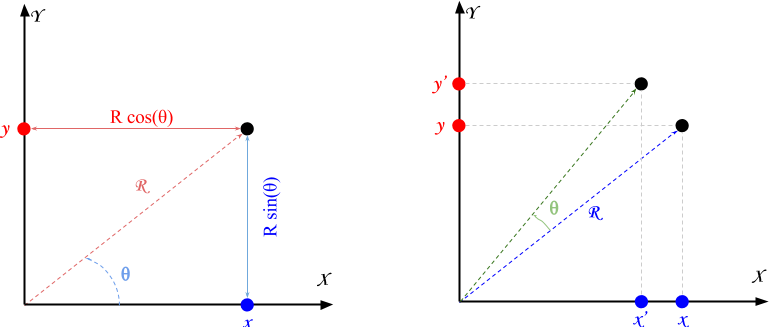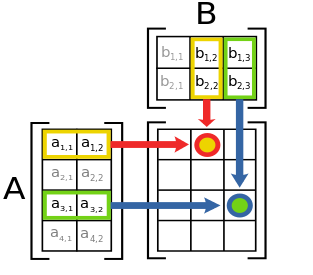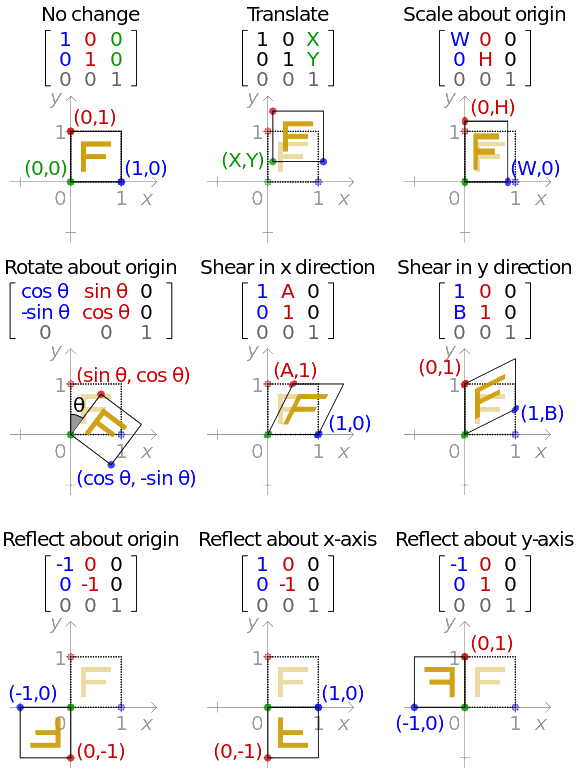This tutorial will introduce the Transformation Matrix, one of the standard technique to translate, rotate and scale 2D graphics. The first part of this series, A Gentle Primer on 2D Rotations, explaines some of the Maths that is be used here.
- Introduction
- Part 1. Matrix notation
- Part 2. Adding translations
- Part 3. Composition
- Part 4. Inversion
- Part 5. Rotation around a point
- Conclusion
Introduction
In the previous post we have seen how a 2D point ![]() can be represented in the plane, and how trigonometry links its Polar and Cartesian representations:
can be represented in the plane, and how trigonometry links its Polar and Cartesian representations:

In a nutshell:
![]()
![]()
The second important result is that any given point ![]() an be rotated by an angle
an be rotated by an angle ![]() around the origin as follow:
around the origin as follow:
![]()
![]()
These are the only two notions you need to understand this tutorial.
Matrix notation
When it comes to 3D graphics, there’s an alternative representation that is often encountered. A rotation can, in fact, be expressed as a matrix multiplication. To do this, let’s express ![]() as the column vector
as the column vector ![]() . The problem is now finding a matrix
. The problem is now finding a matrix ![]() so that:
so that:
![]()
❓ Matrix Multiplication
Remembering matrix multiplication:
![]()
Please, note that the result is a vector with one column. This makes sense, because the result is another point in the 2D plane.

The matrix ![]() can be defined as:
can be defined as:
![Rendered by QuickLaTeX.com \[\underbrace{\begin{bmatrix}\cos\left(\theta\right) & -\sin\left(\theta\right) \\\sin\left(\theta\right) & \cos\left(\theta\right)\end{bmatrix}}_{T\left(\theta\right)}\cdot\begin{bmatrix}x \\ y\end{bmatrix}=\begin{bmatrix}x\,\cos\left(\theta\right) -y\,\sin\left(\theta\right) \\x\,\sin\left(\theta\right) + y\,\cos\left(\theta\right)\end{bmatrix}=\begin{bmatrix}{x}' \\ {y}'\end{bmatrix}\]](https://www.alanzucconi.com/wp-content/ql-cache/quicklatex.com-daad9536a552b3e92cbf54b3e7643e4b_l3.png)
Every rotation of ![]() radians in the 2D plane can be obtained by multiplying a column vector by
radians in the 2D plane can be obtained by multiplying a column vector by ![]() .
.
Adding translations
There are other operations which, unfortunately, cannot be achieved with this matrix. Translations is one of them. What we want is a new matrix ![]() such that:
such that:
![]()
This is not possible with the current setting. In order to obtain this result, we need to modify the way ![]() is represented.
is represented.
![Rendered by QuickLaTeX.com \[\underbrace{\begin{bmatrix}1&0 & t_x \\0 & 1 & t_y \\0 & 0 & 1 \\\end{bmatrix}}_{T\left(t_x, t_y\right)}\cdot\begin{bmatrix}x \\ y \\ 1\end{bmatrix}=\begin{bmatrix}x+t_x\\y +t_y \\ 1\end{bmatrix}\]](https://www.alanzucconi.com/wp-content/ql-cache/quicklatex.com-7ebc1704849fd24e68971e0d2fdd3e5e_l3.png)
The point ![]() is now represented by the three dimensional column vector
is now represented by the three dimensional column vector ![]() . This is necessary in order to make the matrix multiplication works, since the new
. This is necessary in order to make the matrix multiplication works, since the new ![]() now has three rows and columns.
now has three rows and columns.
❓ The Transformation Matrix
This technique is currently being used in most 2D graphics framework. The matrix ![]() is often called the Transformation matrix and can be used to perform the following operations:
is often called the Transformation matrix and can be used to perform the following operations:

Composition
Using matrices to perform transformation has an incredible advantage: they can be multiplied together to perform multiple transformation. A single matrix can hold as many transformation as you like. In a nutshell:
![Rendered by QuickLaTeX.com \[T_2 \cdot\left (T_1 \cdot\begin{bmatrix}x \\ y \\ 1\end{bmatrix}\right)=\left (T_2 \cdot T_1\right)\cdot\begin{bmatrix}x \\ y \\ 1\end{bmatrix}\]](https://www.alanzucconi.com/wp-content/ql-cache/quicklatex.com-f9f0ad177726e4b8c5b6cb48948eb005_l3.png)
This is true because matrix multiplication is an associative operator. It is important to remember, however, that these transformations are not commutative. This means that ![]() is not the same as
is not the same as ![]() . Intuitively, this is obvious: rotating and translating is different from translating and then rotation.
. Intuitively, this is obvious: rotating and translating is different from translating and then rotation.
Inversion
Transformations can be undone. For every transformation matrix ![]() which does rotates or translates, there is a matrix
which does rotates or translates, there is a matrix ![]() which performs the “opposite” operation. This means that if we apply
which performs the “opposite” operation. This means that if we apply ![]() , followed by
, followed by ![]() , we obtain the original point:
, we obtain the original point:
![Rendered by QuickLaTeX.com \[T^{-1} \cdot\left (T \cdot\begin{bmatrix}x \\ y \\ 1\end{bmatrix}\right)=\begin{bmatrix}x \\ y \\ 1\end{bmatrix}\]](https://www.alanzucconi.com/wp-content/ql-cache/quicklatex.com-1b8866aa3b95df8de74fb5da6bd3c5af_l3.png)
By using the associative property, we can get a glimpse of what this matrix is:
![Rendered by QuickLaTeX.com \[\left (T^{-1} \cdotT\right)\cdot\begin{bmatrix}x \\ y \\ 1\end{bmatrix}=\begin{bmatrix}x \\ y \\ 1\end{bmatrix}\]](https://www.alanzucconi.com/wp-content/ql-cache/quicklatex.com-080c2c62e1f111700d2469a447aaf2c0_l3.png)
![Rendered by QuickLaTeX.com \[\left (T^{-1} \cdotT\right)\cdot\begin{bmatrix}x \\ y \\ 1\end{bmatrix}=\mathbb{I}\cdot\begin{bmatrix}x \\ y \\ 1\end{bmatrix}\]](https://www.alanzucconi.com/wp-content/ql-cache/quicklatex.com-c7a6c2e50f9fda2cbdd4c85d73afb12e_l3.png)
![]()
If you have a basic knowledge of matrix algebra, you should recognise this: ![]() is the inverse matrix of
is the inverse matrix of ![]() . Inverting a matrix is a non trivial task, and goes beyond the scope of this tutorial. However, you don’t really need to know how to invert a matrix to undo a transformation. Because of the way the transformation matrix has been constructed, it is always true that:
. Inverting a matrix is a non trivial task, and goes beyond the scope of this tutorial. However, you don’t really need to know how to invert a matrix to undo a transformation. Because of the way the transformation matrix has been constructed, it is always true that:
![Rendered by QuickLaTeX.com \[T\left(-\theta\right) \cdot\left (T\left(+\theta\right)\cdot\begin{bmatrix}x \\ y \\ 1\end{bmatrix}\right)=\begin{bmatrix}x \\ y \\ 1\end{bmatrix}\]](https://www.alanzucconi.com/wp-content/ql-cache/quicklatex.com-43e83b62c926b22b7707692d7ed598e9_l3.png)
![Rendered by QuickLaTeX.com \[T\left(-x,-y\right) \cdot\left (T\left(+x,+y\right)\cdot\begin{bmatrix}x \\ y \\ 1\end{bmatrix}\right)=\begin{bmatrix}x \\ y \\ 1\end{bmatrix}\]](https://www.alanzucconi.com/wp-content/ql-cache/quicklatex.com-8f55f4d1dea4abbe44c26ad1fddc7fe4_l3.png)
The meaning of these two equations should be intuitive to grasp: if you rotate a point of ![]() angles, followed by a rotation of
angles, followed by a rotation of ![]() , you get the original point. The same applies for translations.
, you get the original point. The same applies for translations.
![]()
![]()
From this, it follows that if you have a series of elementary rotations and translations, the inverse of their composition is the composition of their inverses, in reversed order:
![]()
❓ Singular Matrix
From a more general point of view, it is not true that all transformations can be undone. For instance the following transformations cannot be undone:
![Rendered by QuickLaTeX.com \[\begin{bmatrix}0 & 0 & 0 \\0 & 1 & 0 \\0 & 0 & 1\end{bmatrix}\cdot\begin{bmatrix}x \\ y \\ 1\end{bmatrix}\right)=\begin{bmatrix}0 \\ y \\ 1\end{bmatrix}\right)\]](https://www.alanzucconi.com/wp-content/ql-cache/quicklatex.com-6c314b0ea79f581a440a0be92326aedf_l3.png)
Multiplying the
Rotation around a point
As seen in the previous part of this tutorial (A Gentle Primer on 2D Rotations), to rotate around an arbitrary point, we need to first make that our new origin of the Cartesian plane. Then we rotate the point, and finally we restore the origin of the plane. This can be expressed a composition of three transformations:
![]()
It’s important to remember that, despite the order in which they are written, the first transformation is the one on right.
📚 Recommended Books
Conclusion
This post has introduced the transformation matrix, which is one of the standard ways in which transformations are stored and performed in computer graphics. We have explored the following transformations:
- Translation by
 :
:
![Rendered by QuickLaTeX.com \[\underbrace{\begin{bmatrix}1 & 0 & t_x\\0 & 1 & t_y \\0 & 0 & 1\end{bmatrix}}_{T\left(t_x, t_y\right)}\cdot\begin{bmatrix}x \\ y \\ 1\end{bmatrix}=\begin{bmatrix}x + t_x \\x + t_y \\1\end{bmatrix}\]](https://www.alanzucconi.com/wp-content/ql-cache/quicklatex.com-f05823bee9681077444892673444dcca_l3.png)
- Rotation by
 around the origin:
around the origin:
![Rendered by QuickLaTeX.com \[\underbrace{\begin{bmatrix}\cos\left(\theta\right) & -\sin\left(\theta\right) & 0\\\sin\left(\theta\right) & \cos\left(\theta\right) & 0 \\0 & 0 & 1\end{bmatrix}}_{T\left(\theta\right)}\cdot\begin{bmatrix}x \\ y \\ 1\end{bmatrix}=\begin{bmatrix}x\,\cos\left(\theta\right) -y\,\sin\left(\theta\right) \\x\,\sin\left(\theta\right) + y\,\cos\left(\theta\right) \\1\end{bmatrix}\]](https://www.alanzucconi.com/wp-content/ql-cache/quicklatex.com-f473fc2c6b313c6644a3c16575d39704_l3.png)
- Rotation by
 around the point
around the point  :
:
![Rendered by QuickLaTeX.com \[T\left(P_x,P_y\right) \cdot T\left(\theta\right) \cdot T\left(-P_x,-P_y\right) \cdot \begin{bmatrix}x \\ y \\ 1\end{bmatrix}\]](https://www.alanzucconi.com/wp-content/ql-cache/quicklatex.com-69f6f1bc3421fea2eb2a2f42084dc94f_l3.png)
The main advantage of the matrix notation is that transformations can be composed by multiplying their respective transformation matrices. This also allows to “undo” transformation by calculating the inverse of its matrix.
The next post in this series will focus on the geometrical consequences of the equations we have derived. This will help to demystify one of the most misunderstood concept of Maths: complex numbers. Their understanding is essential for quaternions.
Other resources
- Part 1. A Gentle Primer on 2D Rotations
- Part 2. The Transformation Matrix
- Part 3. Rotations in the Complex Plane
- Part 4. Understanding Rotations in 3D
- Part 5. Understanding Quaternions
- Matrices aren’t scary. They’re essential.





Leave a Reply